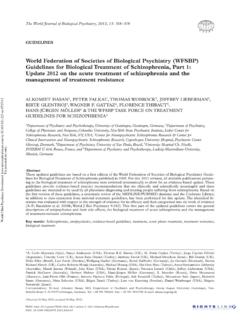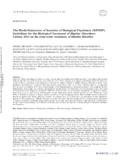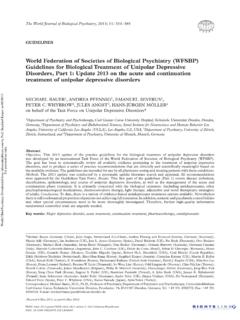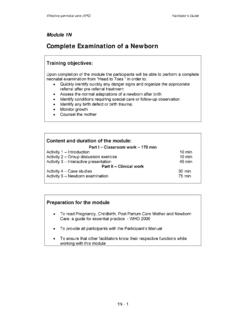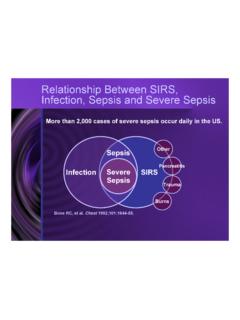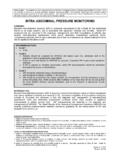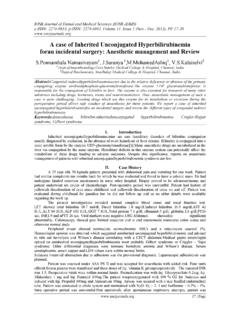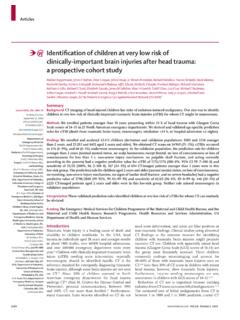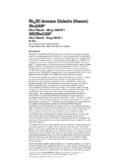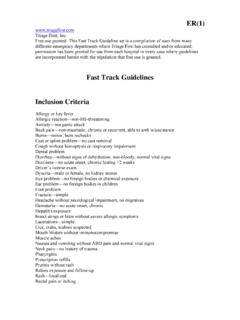Transcription of Guidelines for the pharmacological treatment of anxiety ...
1 A Chair: Robertas Bunevicius (Lithuania), Co-Chair: Siegfried Kasper (Austria), Secretary: Florence Thibaut (France), Members: Wioletta Baranska-Rybak (Poland), Wieclaw J. Cubala (Poland), David Fiellin (USA), Henry R. Kranzler (USA), Alison Moore (USA), Elmars Rankans (Latvia), Jill Rasmussen (UK), Richard Saitz (USA), Djea Saravane (France), Thomas E. Schlaepfer (Germany), Leo Sher (USA), Tang (Hong Kong), Leonas Valius (Lithuania), David Wong (Hong Kong), Larisa M Zhitnikova (Russia), Joseph Zohar (Israel). b Chair: Joseph Zohar (Israel); Co-Chairs: Eric Hollander (USA), Siegfried Kasper (Austria), Hans-Jurgen Moller (Germany); Secretary: Borwin Bandelow (Germany); Members: C.
2 Allgulander, J. Ayuso-Gutierrez, D. Baldwin, R. Bunevicius, G. Cassano, N. Fineberg, L. Gabriels, I. Hindmarch, H. Kaiya, Klein, M. Lader, Y. Lecrubier, Lepine, Liebowitz, Lopez-Ibor, D. Marazitti, Miguel, Oh, M. Preter, R. Rupprecht, M. Sato, V. Starcevic, Stein, M. van Ameringen, J. Vega. Correspondence: Borwin Bandelow, Psychiatry and Psychotherapy, University of G ttingen, von-Siebold-Str. 5, D-37075 G ttingen, Germany. E-mail: (Received 12 August 2011 ; accepted 5 January 2012 ) REVIEW ARTICLE Guidelines for the pharmacological treatment of anxiety disorders, obsessive compulsive disorder and posttraumatic stress disorder in primary care BORWIN BANDELOW 1 , LEO SHER 2 , ROBERTAS BUNEVICIUS 3 , ERIC HOLLANDER 2 , SIEGFRIED KASPER 4 , JOSEPH ZOHAR 5 , HANS-J RGEN M LLER 6 , WFSBP TASK FORCE ON MENTAL DISORDERS IN PRIMARY CARE a AND WFSBP TASK FORCE ON anxiety DISORDERS , OCD AND PTSD b 1 Department of Psychiatry and Psychotherapy, University of G ttingen, G ttingen, Germany.
3 2 Albert Einstein College of Medicine and Montefi ore Medical Center, New York City, NY, USA, 3 Institute of Psychophysiology and Rehabilitation, Lithuanian University of Health Sciences, Palanga, Lithuania, 4 Department of Psychiatry and Psychotherapy, Medical University of Vienna, Vienna, Austria, 5 Division of Psychiatry, Chaim-Sheba Medical Center, Tel-Hashomer, Ramat Gan, Israel, and 6 Department of Psychiatry and Psychotherapy, Ludwig Maximilian University, Munich, Germany Abstract Objective. anxiety disorders are frequently under-diagnosed conditions in primary care, although they can be managed effectively by general practitioners.
4 Methods. This paper is a short and practical summary of the World Federation of Biological Psychiatry (WFSBP) Guidelines for the pharmacological treatment of anxiety disorders, obsessive compulsive disorder (OCD) and posttraumatic stress disorder (PTSD) for the treatment in primary care. The recommendations were developed by a task force of 30 international experts in the fi eld and are based on randomized controlled studies. Results. First-line pharmacological treatments for these disorders are selective serotonin reuptake inhibitors (for all disor-ders), serotonin-norepinephrine reuptake inhibitors (for some) and pregabalin (for generalized anxiety disorder only).
5 A combination of medication and cognitive behavior/exposure therapy was shown to be a clinically desired treatment strategy. Conclusions. This short version of an evidence-based guideline may improve treatment of anxiety disorders, OCD, and PTSD in primary care. Key Words: anxiety disorders , Guidelines , panic disorder , generalized anxiety disorder , social anxiety disorder , pharmacological treatment Introduction anxiety disorders are frequently under-diagnosed conditions in primary care, although they can be managed effectively by general practitioners. The World Health Organization (WHO) and American Psychiatric Association (APA) developed specifi c diagnostic Guidelines for the mental disorders in primary care.
6 This publication is a complementary tool a brief and user friendly diagnostic guideline, developed for general practitioners. It is a short and practical summary of the WFSBP Guidelines for the anxiety disorders, obsessive compulsive disorder (OCD) and posttraumatic stress disorder International Journal of Psychiatry in Clinical Practice, 2012; 16: 77 84 ISSN 1365-1501 print/ISSN 1471-1788 online 2012 Informa HealthcareDOI: J Psych Clin Pract Downloaded from by Prof. Siegfried Kasper on 02/13/13 For personal use B. Bandelow et al. (PTSD) [1], aiming at providing information about how to use modern medications for managing anx-iety disorders in a busy primary care setting.
7 Although the lifetime prevalence of anxiety dis-orders has remained stable over the last decade about 29% the rate of treatment increased, along with the increased awareness about anxiety disor-ders, and the desire to improve quality of life. Patients with anxiety disorders are frequent users of emergency and primary medical services and are at a high risk for suicide attempts and substance abuse. The current conceptualization of anxiety disor-ders includes an interaction of a specifi c neurobio-logical vulnerability (genetic, childhood adversity) and environmental factors (stress, trauma). anxiety disorders are associated with dysfunction of sero-tonin, norepinephrine and other neurotransmitter systems.
8 treatment The WFSBP Task Force conducted a computer-based literature research in order to identify all rel-evant studies showing superiority to placebo and superiority or equivalent effi cacy compared with established comparator treatments. The studies had to fulfi ll certain quality requirements. The categories of evidence are shown in Table I and are based on a systematic analysis of 510 randomized controlled studies. Recommendation grades are based on a synthesis of evidence and the risks of a drug (for example, benzodiazepines have category of evidence A, but only a recommendation grade of 2, due to their addiction potential). treatment is indicated in the majority of patients who fulfi ll the WHO International Classifi cation of Diseases (ICD-10) or APA Diagnostic and Statistical Manual (DSM-IV-TR) criteria for an anxiety disor-der, OCD or PTSD (Table II).
9 The treatment plan is based on the patient s preference, severity of ill-ness, co-morbidity, concomitant medical illnesses, complications like substance abuse or suicide risk, the history of previous treatments, cost issues and availability of types of treatment in a given area. treatment options include drug treatment and psy-chological therapy. Before drug treatment is initiated, it is strongly recommended that the mechanisms underlying psychic and somatic anxiety be explained to the patient (brochures that explain the typical fea-tures of the patient s condition, treatment options, and adverse drug effects might be useful). Compli-ance with drug treatment can be improved when the advantages and disadvantages of the drugs are explained carefully.
10 treatment should continue for at least 6 24 months after remission has occurred, in order to reduce the risk of relapse, and may be stopped only if all, or almost all, symptoms disappear. Drug treatment : available compounds Selective serotonin reuptake inhibitors (SSRIs), serotonin-norepinephrine reuptake inhibitors (SNRIs), and pregabalin are recommended as fi rst-line drugs due to their favorable risk-benefi t ratio, with some differentiation regarding the various anx-iety disorders (Table III). SSRIs . SSRIs are indicated for the anxiety disorders, OCD, and PTSD. Although treatment with SSRIs is Table I. Categories of evidence and recommendation grades (Table III gives the categories of evidence for all recommended drugs).

